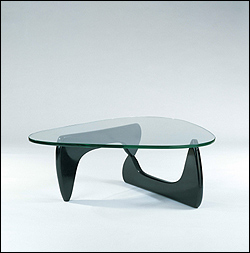SAM’s exhibition of art objects, stage props, and home furnishings by the late Isamu Noguchi is well worth a visit, not so much because of the intrinsic artistic merits of the work as to experience a rare and eerily apt collaboration between two artists, one living, one dead. The living artist is the stage director/designer Robert Wilson, whose work has been little seen here in his native land, but who is one of the most significant players on the international operatic and theatrical scene, above all in German-speaking Europe, where he is headline news, usually referred to familiarly as “Bob.” This show (through Sept. 5; 200 University St., 206-654-3100, www.seattleartmuseum.org) comes from the Vitra Design Museum in Weil am Rhein, Germany.
Though active throughout one of the most radical periods of change in art history (he was born in 1904 and died in 1988), Noguchi went his own way, standing well apart from the roiling movements and manifestos of his time. The barbaro-Cretan stage props he created for many of the myth-saturated dance works of Martha Graham are powerfully redolent of the period their collaboration began, the 1930s—so powerfully that without referring to the catalog, a casual viewer would be hard put to distinguish those made in the late 1950s from the earliest. You could strain to derive Noguchi’s approach to the plastic arts from that of Constantin Brancusi, the great Romanian sculptor with whom he apprenticed briefly in 1927, but the two men’s sensibilities were very different. Brancusi’s forms, whether sleek or blocky, vibrate with contained energy. Noguchi’s, even at the most expressionistic, are in themselves comparatively inert, depending on context for their power.
That quality is a serviceable definition of the “decorative” in art: The object is in the service of something beyond itself, even if it’s the center of attention—the way a pearl necklace implies a woman’s neck. In SAM’s show, the context is provided by Wilson’s installation, which disperses the occasional portrait bust and interior design element (a coffee table, paper lighting fixtures, a Zenith table-model radio) among dramatically illuminated masks and props from Graham productions, with each of the four rooms of the exhibition bathed in appropriate ambient sound (music commissioned for Graham ballets, gusty nature noises, the subdued chatter of a cocktail party).
The latter sound choice seems to be Wilson’s little joke (it was recorded at one of his own celebrity-packed soirées), but it’s a rather risky one. It foregrounds one of the aspects of Noguchi’s career that renders it so curiously like Wilson’s own. You can’t describe either artist as appealing to “popular” taste (unless you include Noguchi’s wire-and-paper lampshades, now a commodity found from Pier 1 to Crate and Barrel). But both managed to be steadily “fashionable,” though in somewhat different ways. Apart from the work for Graham, Noguchi is probably best known for the wood-and-glass coffee table he created for the Herman Miller furniture collection in the 1940s. He also prospered later in life creating public art works, thanks to his impeccably modernist credentials and his largely spurious but highly modish East-meets-West image. That his work could not offend the most prudish or reactionary sensibility made him an easy choice for commissions like Volunteer Park’s massive granite Black Sun and the downtown Federal Building’s Landscape of Time.
It must be abundantly clear by this point that I believe Noguchi to be a very minor artist, to the extent that he is an artist at all in the narrow sense of the word. But then, I feel much the same way about Wilson. Both are competent if never inspired craftsmen; both in more hard-nosed and utilitarian artistic eras might have done very well designing shop windows or bric-a-brac for fashionable salons. But the greatest gift of both is the ability to provide their customers the illusion of experiencing high art without the effort required actually to do so.
As such, this show is a powerful demonstration of the way “design” has begun to displace “art” as a fit focus for museum exhibitions. Bellevue Arts Museum reopens soon with “art, craft, design” as its declared focus; SAM’s next big exhibition—its last before closing until 2007—is devoted to the work of late 19th-century America’s favorite interior decorator, Louis Comfort Tiffany. The SAM Web site declares the latter “an artist for the ages.” This is piffle, of course, but it shows as plainly as smokestack fume which way the cultural wind is blowing.
A valuable photo archive of Noguchi designs for Martha Graham dance works can be found at www.noguchi.org/graham.html.








